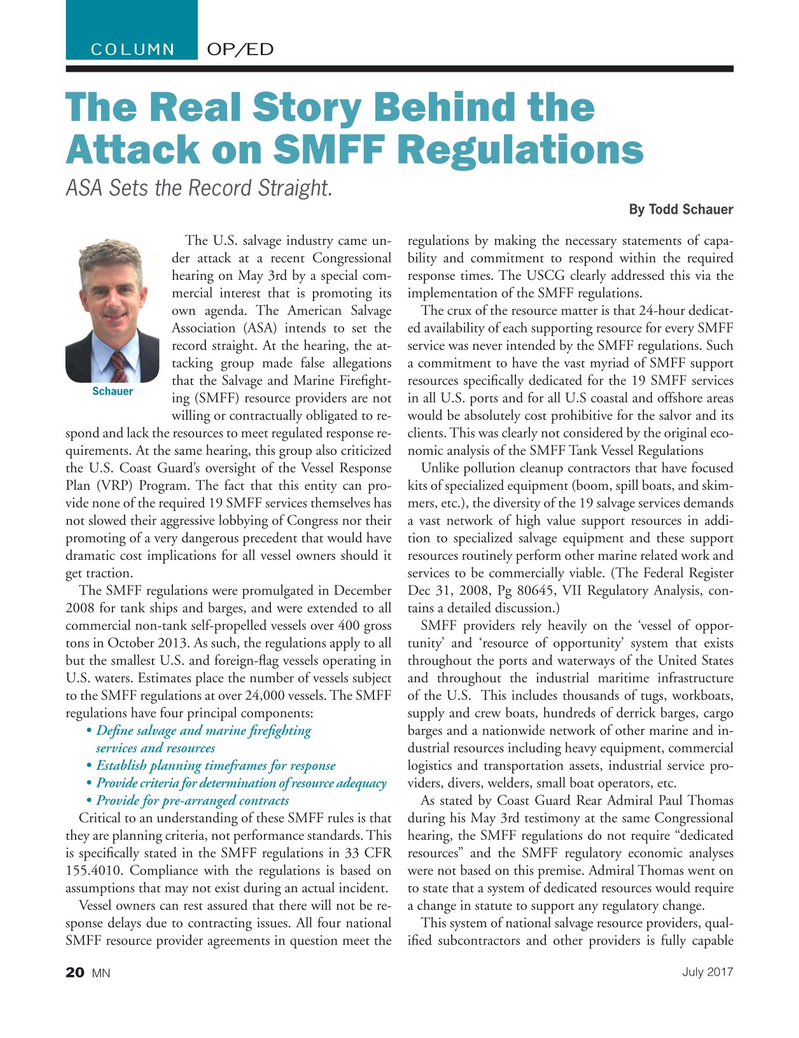
Page 20: of Marine News Magazine (July 2017)
Propulsion Technology
Read this page in Pdf, Flash or Html5 edition of July 2017 Marine News Magazine
COLUMN OP/ED
The Real Story Behind the
Attack on SMFF Regulations
ASA Sets the Record Straight.
By Todd Schauer
The U.S. salvage industry came un- regulations by making the necessary statements of capa- der attack at a recent Congressional bility and commitment to respond within the required hearing on May 3rd by a special com- response times. The USCG clearly addressed this via the mercial interest that is promoting its implementation of the SMFF regulations.
own agenda. The American Salvage The crux of the resource matter is that 24-hour dedicat-
Association (ASA) intends to set the ed availability of each supporting resource for every SMFF record straight. At the hearing, the at- service was never intended by the SMFF regulations. Such tacking group made false allegations a commitment to have the vast myriad of SMFF support that the Salvage and Marine Fire? ght- resources speci? cally dedicated for the 19 SMFF services
Schauer ing (SMFF) resource providers are not in all U.S. ports and for all U.S coastal and offshore areas willing or contractually obligated to re- would be absolutely cost prohibitive for the salvor and its spond and lack the resources to meet regulated response re- clients. This was clearly not considered by the original eco- quirements. At the same hearing, this group also criticized nomic analysis of the SMFF Tank Vessel Regulations the U.S. Coast Guard’s oversight of the Vessel Response Unlike pollution cleanup contractors that have focused
Plan (VRP) Program. The fact that this entity can pro- kits of specialized equipment (boom, spill boats, and skim- vide none of the required 19 SMFF services themselves has mers, etc.), the diversity of the 19 salvage services demands not slowed their aggressive lobbying of Congress nor their a vast network of high value support resources in addi- promoting of a very dangerous precedent that would have tion to specialized salvage equipment and these support dramatic cost implications for all vessel owners should it resources routinely perform other marine related work and get traction. services to be commercially viable. (The Federal Register
The SMFF regulations were promulgated in December Dec 31, 2008, Pg 80645, VII Regulatory Analysis, con- 2008 for tank ships and barges, and were extended to all tains a detailed discussion.) commercial non-tank self-propelled vessels over 400 gross SMFF providers rely heavily on the ‘vessel of oppor- tons in October 2013. As such, the regulations apply to all tunity’ and ‘resource of opportunity’ system that exists but the smallest U.S. and foreign-? ag vessels operating in throughout the ports and waterways of the United States
U.S. waters. Estimates place the number of vessels subject and throughout the industrial maritime infrastructure to the SMFF regulations at over 24,000 vessels. The SMFF of the U.S. This includes thousands of tugs, workboats, regulations have four principal components: supply and crew boats, hundreds of derrick barges, cargo • De

 19
19

 21
21
